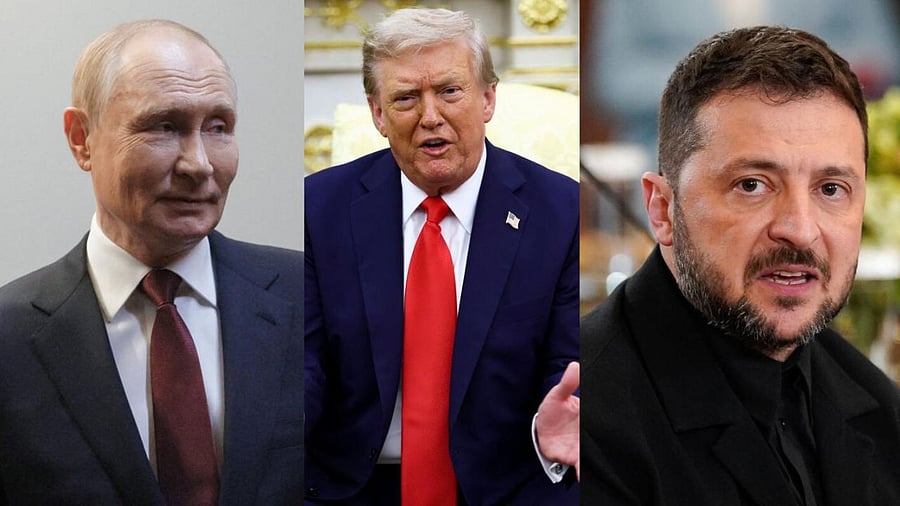
Vladimir Putin, Donald Trump, Volodymyr Zelenskyy
Credit: Reuters Photo
The comprehensive 28-point plan put forth by the United States marks a significant development in efforts to resolve the fighting in Ukraine, which is nearing its fourth year. The US plan – not to be confused with the US position – outlines modalities for the transfer of territories, freezing the conflict along the current lines in other regions, security guarantees, and the prospect of reintegration of Russia into the Western-backed financial architecture. With certain parameters addressed, Russian President Vladimir Putin welcomed the plan as a framework for beginning talks to end the war.
Interestingly, citing that the plan resonates with Russia’s rationale for its invasion of Ukraine, the European Union and Ukraine rejected the plan. Even so, President Donald Trump’s clarification that the document is not a final draft introduces pragmatism into the discussion of bringing the war to a negotiated settlement. The way ahead is a path re-visited, and extremely fragile, with a high likelihood of hostilities resurging. In other words, half-hearted attempts to bring peace without addressing root causes or red lines will only perpetuate anxieties and prolong the conflict.
The US plan is argued to be a culmination of efforts undertaken to bring an end to the conflict. Taking cognisance of the situation in the front, with Russian forces reporting new gains, marked by the fall of a key logistics town, Pokrovsk in Donetsk region, and Russian forces making gains in Kupyansk in Kharkiv region, in Trump’s calculus, it has become increasingly clear that Ukrainian forces will not be able to stall the Russian advance. Additionally, the timing is noteworthy; given its release in the wake of major oil sanctions against Russia, the plan is said to have absorbed the shocks of the sanctions in the market.
The plan can be divided broadly into four segments. First, where the document calls for the recognition of Crimea, Donetsk, and Luhansk as de facto Russian territories. The regions of Kherson and Zaporizhzhia would be frozen along the current lines; Russia would relinquish control in other regions outside of this. Second, Ukraine’s military strength would be capped at 600,000 troops (at present, close to 900,000), the state would receive reliable security guarantees; however, NATO membership would be a non-starter, and NATO’s expansion eastward would be halted. Ukraine, however, would be allowed to join the EU. Russia and the US would agree to extend the validity of the non-proliferation treaties and control of nuclear weapons.
Third, $100 billion of Russian frozen assets would be invested in US-led efforts to rebuild Ukraine. Frozen funds in Europe will be unfrozen, and the remainder of the funds will be invested in joint projects between Russia and the US. The plan will also cover provisions to allow Ukraine to use the Dnieper river, amnesty for the combatants, and conclusion of a non-aggression treaty for three decades between Russia, Ukraine, and the US.
The Russian perception
Putin reported the existence of the plan in Russia’s national security council. He welcomed Trump’s efforts in bringing peace and highlighted that the document could serve as the basis for a final peace settlement. However, the Russian President reiterated that there has been no new discussion of this text, as Ukraine has yet to agree on the draft resolution.
Despite Trump’s previously growing frustration against Russia, manifested in the preceding decision to impose secondary tariffs, sanctions, and beginning deliberations on resuming nuclear testing, Russia’s response has been rather moderate, unlike with the previous administration. Since Trump took office. The political contacts between the two countries increased. Even with the US now officially taking a position palatable to Moscow’s interests, Russia is sceptical of Ukraine and the EU accepting this proposal.
Considering Ukraine’s position on the inviolability of its territory, it was hardly surprising that it rejected the plan. The EU expressed concerns over the proposed limitations on Ukraine’s military and stated that the plan required additional work, as the EU is not in agreement with the status of the territories and with how Trump proposes to use the frozen assets, the majority of which are held in Europe.
That said, unlike the previous discussions of an endgame, the current document gives the EU a greater role. With Trump’s deadline approaching, even with the current opposition on fundamental questions, the narrative around the endgame has shifted. Minor agreements may be reached, while the fundamental questions pertaining to security guarantees, territorial integrity, the management of frozen Russian assets, and sanctions relief are therefore likely to be addressed only gradually, over multiple rounds of negotiations.
(The writer is a junior fellow at the Observer Research Foundation)
Disclaimer: The views expressed above are the author's own. They do not necessarily reflect the views of DH.